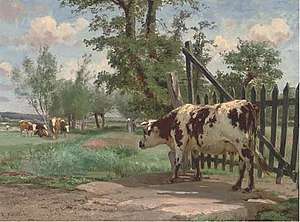Léon Barillot
Léon Barillot (11 October 1844, Montigny-lès-Metz - 8 February 1929, Paris) was a French painter and engraver. He specialized in animals and landscapes.


Biography
His father owned a wallpaper factory, where he worked as a pattern designer. On the advice of Auguste Migette, a local painter and designer, he went to Paris to continue his artistic studies in the workshops of Léon Bonnat at the École nationale supérieure des beaux-arts.
He returned to Metz at the beginning of the Franco-Prussian War and remained there during the ensuing siege. After the Commune, he went back to Paris. At that time, he created numerous engravings and etchings for the publishing firm of Alfred Cadart, among others; notably, an album called L'Illustration nouvelle and the series, L'Eau forte en...[1][2].
In 1872, following the annexation of his hometown by the Germans, he chose French citizenship, settled permanently in Paris and opened a studio near the Opera.[3] He was awarded medals at the Salon in 1880 and 1884. He also exhibited and won awards in London and Melbourne. At the Exposition Universelle (1889), he received a gold medal. He was known for painting en plein aire. His favorite places were along the Seine, in Sologne and in Charolais, home to several popular breeds of cattle and sheep.[4]
His last major award was Grand Prize at the Exposition internationale et coloniale (1894) in Lyon. The following year, he was named a Chevalier in the Legion of Honor.[5]
He died in Paris and was interred at the Cimetière du Montparnasse.
References
- Notice de L'Illustration nouvelle, Catalogue général of the BnF.
- Notice de L'Eau forte en..., Catalogue général of the BnF.
- Catalogue de l'Exposition des beaux-arts de Montpellier 1896
- Works @ the Base Joconde.
- Dossier Léon Barillot in the Base Léonore